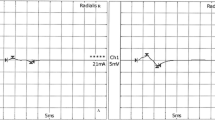Abstract
Some evidences highlighted a higher clinical expression of hereditary neuropathy with liability to pressure palsy (HNPP) in males, and a higher load of traumatic nerve injuries due to different occupational activity has been invoked to explain this observation. It is unknown whether this increased clinical impairment corresponds to a greater electrophysiological involvement. Thus, we compared clinical and electrophysiological features between men and women in a large cohort of HNPP patients. Nerve palsies and electrophysiological abnormalities were more frequent in men, and electrophysiological findings which differentiated males from females did not show any age-related worsening. In conclusion, our findings showed a higher clinical and electrophysiological involvement in males which does not seem related to different cumulative nerve damage over time. We believe that the higher disease expression may increase the chance to detect the disease in males and, thereby, to underestimate the HNPP diagnosis in females.

Similar content being viewed by others
References
Gouider R, LeGuern E, Gugenheim M, Tardieu S, Maisonobe T, Léger JM, Vallat JM, Agid Y, Bouche P, Brice A (1995) Clinical, electrophysiologic, and molecular correlations in 13 families with hereditary neuropathy with liability to pressure palsies and a chromosome 17p11.2 deletion. Neurology 45:2018–2023
Uncini A, Di Guglielmo G, Di Muzio A, Gambi D, Sabatelli M, Mignogna T, Tonali P, Marzella R, Finelli P, Archidiacono N et al (1995) Differential electrophysiological features of neuropathies associated with 17p11.2 deletion and duplication. Muscle Nerve 18:628–635
Andersson PB, Yuen E, Parko K, So YT (2000) Electrodiagnostic features of hereditary neuropathy with liability to pressure palsies. Neurology 54:40–44
Li J, Krajewski K, Shy ME, Lewis RA (2002) Hereditary neuropathy with liability to pressure palsy: the electrophysiology fits the name. Neurology 58:1769–1773
Rizzuto N, Moretto G, Galiazzo Rizzuto S et al (1993) Clinical spectrum of the tomaculous neuropathies. Report of 60 cases and review of the literature. Ital J Neurol Sci 14:609–617
Mouton P, Tardieu S, Gouider R, Birouk N, Maisonobe T, Dubourg O, Brice A, LeGuern E, Bouche P (1992) Spectrum of clinical and electrophysiologic features in HNPP patients with the 17p11.2 deletion. Neurology 52:1440–1446
Koike H, Hirayama M, Yamamoto M, Ito H, Hattori N, Umehara F, Arimura K, Ikeda S, Ando Y, Nakazato M et al (2005) Age associated axonal features in HNPP with 17p11.2 deletion in Japan. J Neurol Neurosurg Psychiatry 76:1109–1114
Infante J, García A, Combarros O, Mateo JI, Berciano J, Sedano MJ, Gutiérrez-Rivas EJ, Palau F (2001) Diagnostic strategy for familial and sporadic cases of neuropathy associated with 17p11.2 deletion. Muscle Nerve 24:1149–1155
Sereda MW, Meyer zu Hörste G, Suter U, Uzma N, Nave KA et al (2003) Therapeutic administration of progesterone antagonist in a model of Charcot-Marie-Tooth disease (CMT-1A). Nat Med 9:1533–1537
Bai Y, Zhang X, Katona I, Saporta MA, Shy ME, O’Malley HA, Isom LL, Suter U, Li J (2010) Conduction block in PMP22 deficiency. J Neurosci 30:600–608
Author information
Authors and Affiliations
Corresponding author
Additional information
F. Manganelli and C. Pisciotta contributed equally to this work.
Rights and permissions
About this article
Cite this article
Manganelli, F., Pisciotta, C., Dubbioso, R. et al. Electrophysiological comparison between males and females in HNPP. Neurol Sci 34, 1429–1432 (2013). https://doi.org/10.1007/s10072-012-1258-8
Received:
Accepted:
Published:
Issue Date:
DOI: https://doi.org/10.1007/s10072-012-1258-8




